Back to page 1
The Design
Let’s take a moment and think about the objectives that heavily influenced the design of Marlins Park. Well, being able to see the downtown skyline was “the fundamental organizational principle” according to Sherlock. There also needs to be a roof to keep out the frequent afternoon thunder showers and keep in air conditioning. That roof needs to move, though, so games can be played outdoors when the weather allows and, very importantly, to permit the sun to shine on the natural grass. The facility needs to be modern and full of art, plus it needs to be intimate, as only 37,000 seats are needed. In order to command top dollar, the luxury suites should be unusually close to the field and have great vantage points.
And most of all, it must say MIAMI loud and clear.
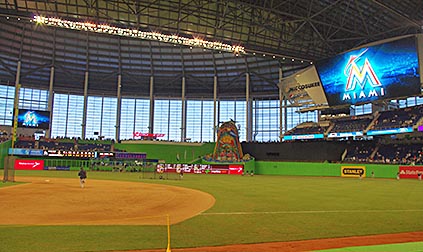 |
How does Marlins Park score in each of these areas? I would say very, very well, with one possible exception. Yes, there are only 37,000 seats here, but I’m not sure I can characterize the feeling as “intimate” in the way Fenway or PNC Park are. When you’re inside the park, it doesn’t matter whether the roof is open or closed. You feel like you are in a very large venue.
That doesn’t make the sight-lines bad. Far from it. I ventured to just about every seating section in the ballpark, and I thought the view of the action was more than adequate, especially when compared to Sun Life Stadium.
Let’s start with the playing field and work our way up. Marlins Park was designed to bring the field-level seats very close to the action, and the distance from the backstop to home plate is indeed a short 47 feet. In the outfield, the idea was for the walls to be reachable by hitters, especially in center field, where it was almost impossible to hit a HR in Sun Life Stadium. Well, it appears that batters are still going to have a hard time hitting it out to center, as the deepest point is 420 feet, and the wall there is taller (at 16 feet) than anywhere else in the outfield.
The wall also curves there, as this is the base of the Home Run Sculpture (lower right). The power alleys are also pretty spacious, as it’s 386 to left center and a mighty 392 feet to right center. The left-field foul pole is 344 feet from home, and it’s a fairly normal 335 down the right-field line.
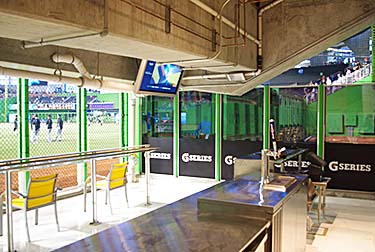 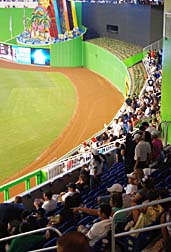 |
There are two areas where fans watch the game by looking through the outfield fence. The Bullpen Terrace (above left) can be reserved by groups, and it not only permits you to see the field through the right-field fence, you can also peer into the visitors’ bullpen. The other such area is the aforementioned Clevelander lounge — named for the famous art-deco hotel in Miami’s South Beach — which has seats just beyond the left-field fence. You can also see into the home bullpen.
And while we’re examining the field level of the ballpark, let’s discuss one of the two elements that generated the most buzz prior to the facility’s opening: the fish tanks (the other being the Home Run Sculpture, which we’ll describe when we’re talking about the park’s art). As you’ve no doubt heard, there are two 450-gallon aquariums embedded in the backstop behind home plate. While marlins are far too large to fit in such a confined space, the concept seems logical given that the team’s nickname is a fish, and Biscayne Bay is a scant two miles away.
However, while I’ll give the design team high marks for innovative thought, my personal opinion is that the fish tanks are much ado about nothing.
Here’s why: the tanks are so low to the ground (below) that fans in the stands — even those close by in the exclusive Diamond Club seats — will barely notice them; even if you take a close look in the tanks, the tropical fish in them are relatively small, possibly giving you the false impression that there are no fish in them at all; the two tanks are so far apart that when the TV camera in the outfield shows a pitch coming to the batter, the aquariums are typically not even visible in the shot. I’m sure it sounded like a brilliant idea when it was first mentioned in a design meeting, but in practice, I don’t think the fish tanks are much of a feature at all — unless you happen to be sitting in the first row right next to them. Now, if they would’ve placed large tanks with colorful fish up on the concourse where fans could easily watch them swim around, then I would consider that a great move … but not next to the ground in the backstop.
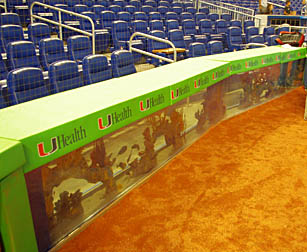 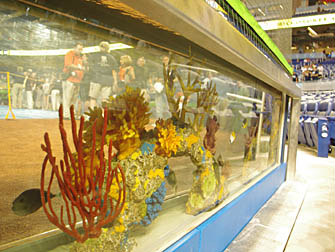 |
One level up from the field level is the concourse that the Marlins refer to as the Promenade. Since the entryways on the exterior of the park are at street level, you must use stairs or escalators (or the lone ramp on the West Plaza) to reach the Promenade.
This wonderfully wide concourse is, for the most part, “open” — meaning you can see the field while you’re walking to the concession stands or rest rooms. This is also the only level where you can make a 360-degree trek around the interior of the ballpark. Along your walk, you’ll encounter countless concession stands, a bobble-head collection that is not to be believed, the moveable glass panels in the outfield, the stairs and elevators that take you up to the Home Run Porch seats high above right and center field, the un-ignorable Home Run Sculpture … and three elements that bear further description. One is (to me) clearly a flaw in the park’s design, one that really is a brilliant design feature (unlike the fish tanks) and the other is a way of differentiating “neighborhoods” within the ballpark that would only work in Miami.
First, the flaw. There is a full retail store that is accessed from the outside of the ballpark on the West Plaza. In addition, there is a full retail store on the Promenade concourse. The latter, though, is simply too small. Fans have to wait in long lines (below left) just to get inside the cramped store.
The solution would’ve been to combine these two retail spaces into a single two-level shopping experience. The door on the lower level would be open when there’s no game going on (while the doors that lead to the concourse on the upper level would be locked when there’s no game), and vice versa when there is a game in process. With this approach, the Marlins could avoid stocking duplicate merchandise in two different stores, and while the Marlins are playing a game, lines getting into the two-level retail operation would be short or non-existent because of all of the square feet on the two levels. You’d just need stairs and an elevator in between levels. Populous utilized an approach quite similar to this in their Dow Diamond ballpark in Midland, Michigan.
I’m not the only one who feels that the two stores should be a single, dual-level operation. Roger Kitch, the team’s Director of Retail Operations, is expecting at least a 500% increase in sales in Marlins merchandise from 2011 to 2012, thanks to the switch from “Florida” to “Miami” and, of course, the new park. However, he told me he has already seen that he doesn’t have enough space in either store, causing him to jokingly suggest to his bosses that they carve out more display space above the ceiling tiles in the street-level store.
The counter argument comes from Greg Sherlock of Populous. He pointed out that having a two-level store was “tested,” but wasn’t feasible given the desire to have the West Plaza “flanked with the main ticketing gates at the north and south ends (while) the main retail is centered, activating the plaza.” Besides, he pointed out, “the new brand of the team is experiencing phenomenal success,” but that will settle down in time. In the meantime, additional kiosks selling merchandise will be added around the stadium.
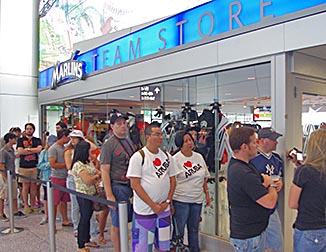 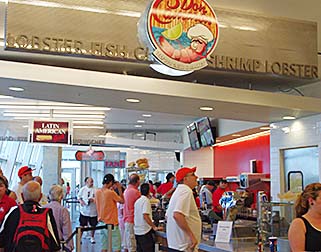 |
The design feature I view as being brilliant is the Taste Of Miami alcove (above right) behind the Promenade level near the left-field foul pole. Here you’ll find concession stands operated by three local restaurants, each offering their signature dish so fans can taste, as the Marlins put it, “the culinary flair of South Florida.”
The method of differentiating areas within the ballpark is done by color, in a way that would only work in Miami. Loria tells of a trip to the Miro Foundation, founded by the Spanish artist Joan Miro. The Marlins’ owner told the Miami Herald that he came to realize that Miro’s “palette was about color — red, yellow, blue and green.” So he brought back samples of Miro’s favorite shades of those colors, and the consensus was that “we would divide up the building into those four colors.”
Indeed, the walkway and wall tiles on the Promenade behind home plate are a deep blue. Behind first base, they are yellow. Behind third base, a vibrant red. And as everyone who has watched a game on TV from Marlins Park already knows, the outfield is a bright, bright lime green. This would only work in Miami.
To me, the most fascinating aspect of the four quadrants of color is what happens where two colors meet. There isn’t an abrupt change from, say, yellow to blue. Instead, over the course of about 30 feet, there is a transition where one color fades out and the other color becomes more dominant (below left). And this isn’t just true of the floor. It’s also done on the walls.
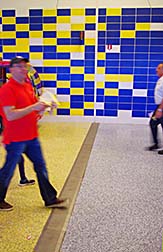 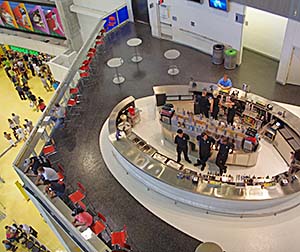  |
As we move up a level from the Promenade, we have the suites on the Founders level and, right above them, the Lexus Legends Level. The Founders Suites are stunning, and might be the closest to home plate of any suites at an MLB facility I’ve ever seen. The suites are also “stacked” in an unusually vertical way, almost like condos in a high rise (above right). Again, this keeps your best-paying customers closer to the action.
As the “Lexus” name implies, this is where the upper suites and club seating is located — with the latter being divided into Legends Platinum, Legends Gold and Legends Silver sections. You typically can’t see the field from this concourse, but you will continue to see interesting uses of geometry, with curving walls and fascinating angles.
The top seating level is called Vista. If your seats are here, or you just want to visit it, make a point to check out the “ends” of this level, near each foul pole. On the left field side, you’ll see there are very long escalators that take fans up and down between the Promenade and the Vista. On the right field end (where you’ll notice a concession stand that isn’t behind any seating sections at all, and you’ll wonder why in the world it’s there), take a gander over the edge (above center) and marvel at the geometry: a perfectly oval bar right below you and everything but right angles everywhere you look. It’s really stunning.
So we’ve now worked our way up from the field level to the Promenade to the Founders Suites to the Legends Level to the Vista … which leaves only the roof to discuss. And there really is a lot to say about these roof panels!
The longer I looked up at the panels and the railroad-like tracks on which they slide back and forth, the more they looked uneven to me. Further, aerial shots of the ballpark almost made the panels look like parallelograms rather than the rectangles you would expect. Was this an optical illusion?
“The rail to the south is lower,” explained Sherlock. “This allows for sun exposure to the southern region of the grass field.” And the non-rectangular roof panels? “The slight shift in the roof geometry aligns with the seating terrace geometry below.” Not only that, it simplified the opening and the closing of the panels.
“We tested as many options (for the roof) as we could conceive in the beginning,” Sherlock continued. They ultimately arrived “at the optimal solution” which allowed the sun to reach the grass and permitted Marlins Park “to feel like an open-air ballpark when the roof is open.” The structure on which they decided has three moveable roof panels that travel along two 750-foot-long tracks at about 39 feet a minute. These panels weigh a total of 19-million pounds, and even with that amount of weight, the transporting mechanisms are so energy-efficient that it costs less than $10 of electricity to open or close those panels.
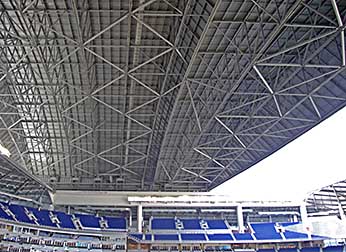 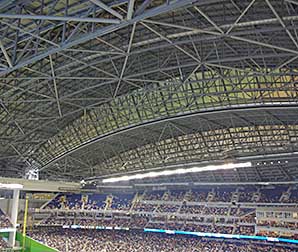 |
| On the left, the massive panels are sliding from left to right, to close the roof so the air conditioning can start to cool the interior. The panels are completely closed on the right. This shot was taken from the upper deck well beyond third base, looking at foul territory behind first base. The center panel, which is 200 feet above second base when closed, is at the top of the shot. |
If you attend a Marlins home game, the chances are very high that you’ll be indoors. Going into their first season in Marlins Park, the team estimated that 70 of the 81 games would be played with the roof closed.
Of the six MLB stadiums that have some sort of retractable roof, Safeco Field and Marlins Park stand head and shoulders above the other four. And while Miller Park and Safeco attempt to mix in a strong dose of “retro” in their exteriors, there is absolutely none in Miami.
Anyway, this roof — just like everything else about the design of Marlins Park — is a marvel.
The Essentials
When over $500 million is spent on a building, you’d expect it to be impressive — and Marlins Park is indeed incredible. So what’s it like to attend a game at the newest playground on the Major League scene?
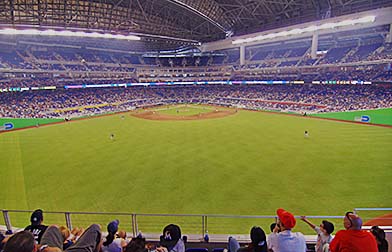 |
Let’s look first at what it will cost you. If you drive instead of taking Miami’s Metrorail system, it would be good idea to arrive early. As we’ve discussed, the availability of parking is a hot topic. If you plan ahead and purchase a parking pass online for one of the four main garages, it will cost you $15, which isn’t unreasonable when compared to other MLB stadiums. If you don’t already have a pass, and if there is room in one of the garages, they’ll let you park for $25.
As mentioned earlier, a better bet might be to head to the street-level lots beneath the interchange of Dolphin Expressway and 12th Avenue. The cost there is $10, and your walk to the park is from half a mile to eight-tenths of a mile, depending on where in the system of lots you end up.
Are tickets expensive? Well, that depends on a high number of factors. You see, with the move to the new ballpark, the Marlins switched to “dynamic ticket pricing,” which the majority of MLB teams now employ in one manner or another. For the Marlins, if you try to purchase seats for an upcoming game that is nearly sold out against an in-demand opponent, you will pay significantly more than if you’ll settle for seeing the Pirates on a Tuesday night. While it’s impossible to give you every possible price for every section for every game, I can tell you this: it’s a lot more expensive to attend a game in Marlins Park than it was at Sun Life Stadium, but that’s how it should be.
Team Marketing Research (TMR) looks at two ways of comparing the cost of going to a game. One is to look only at ticket prices, and the other is to factor in a “shopping basket” of identical items from all of the teams — parking, four average-priced tickets, two beers, four soft drinks, four hot dogs, two caps and two programs.
When TMR examines just the cost of an average ticket (take the total revenue from a sell-out and divide by the number of seats in the place), the Marlins seemed to be a bargain in 2011 — when you ignore how awful the stadium was. The Marlins’ average ticket was $19.06, which was less expensive than 22 of the 30 MLB teams. The cheapest, in case you’re interested, were the Pirates at $15.30. In 2012, the average price of a Marlins ticket has more than doubled, to $40.35. Based on 2011 numbers, that would rank fifth.
When you factor in all of the costs associated with attending a game, the resulting figure is referred to as the Fan Cost Index (FCI). TMR reported that the Marlins’ FCI in 2011 was $170.24, which was below the MLB average by $27. At the new park in 2012, the FCI has jumped to $272.40 … but keep in mind you don’t have to worry about rain delays any more, plus you’ve got air conditioning.
To give you an idea of the range of ticket prices under the new dynamic-pricing system, the Miami Herald checked a variety of seat costs for two games — against the Diamondbacks in April and against the Red Sox in June. Tickets not in the premium sections ranged from $13 to $70 for the D-backs and $30 to $100 for the Sox. That’s quite a difference, especially for the cheapest seats.
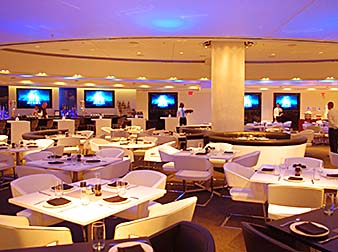  |
The ultra-exclusive seats, by the way, are typically only sold as season tickets. In the Diamond area right behind the backstop (where you can almost see the fishies swimming in those tanks), all 384 tickets are sold out for 2012. Depending what row the seat is in, it can cost $225, $250, $300 or $395. The price includes a parking pass and access to the incredibly upscale Diamond Club dining area (above left) under the stands. The restaurant, by the way, is oval-shaped, not rectangular.
I can’t leave out the Clevelander lounge area (above right) underneath the left-field stands. There’s room for 250 fans here, and there are three ways to enter the lounge — directly from outside the stadium; down escalators near the Taste Of Miami area on the Promenade concourse; or a grand curving staircase along the front of the left-field wall, right behind the Home Run Sculpture … an area often reached in batting practice and occasionally by home-run balls during games. Note that you can’t simply wander into this area without a ticket that is specifically for the Clevelander, and those tickets cost $50 apiece unless it’s a high-demand “gold” game. Then they’re $75.
Once you’re in the Clevelander, the art-deco South Beach vibe is unmistakable — swimming pool, a live DJ, an exotic bar, scantily clad waitresses … and, oh yeah, if you really want to watch baseball, the left-field fence is covered with transparent mesh, so you can see the game.
How expensive is it to eat at Marlins Park? Well, as you’d expect, there aren’t bargain-basement prices on concessions here … and to be honest, to do justice to the incredible and wonderful array of foods available at this new facility would necessitate a review as long as this entire article on this ballpark.
So let’s just hit a few high points. Levy Restaurants has the concessions contract at Marlins Park, and they took their job seriously. The quality of the food is absolutely top-notch — at least as good as you’d expect in a nice sit-down eatery. Take the hamburger served at their Burger 305 stands around the park. “We start with a special blend of meats that is done just for us. It blends short-ribs, brisket and chuck,” explained John Nicely, Area Chef for Levy. “We put the (cooked) patty on a potato bun — always toasted — with American cheese, fresh pickle, fresh, shredded iceberg lettuce and two slices of tomato that was grown in Homestead, Florida.” It costs $8.50 with one patty, or $9.50 for a Double-Play Burger, and it is as good a hamburger as I’ve ever tasted.
Perhaps you’ve read that Marlins Park features foods from the home cities of the opponents coming to Miami. For example, when the Yankees played two exhibition games prior to the start of the 2012 regular season, the Kosher Korner concession stand, located on the Promenade level near the right-field foul pole, flew in the ingredients for a true New York-style knish. The manager of the stand, Mitchell Rubensteen (shown below center, holding a knish), told me that they also carry “our own varieties of knishes, as well as a kosher hot dog wrapped in a knish.” As is the case with everything sold at this stand, these items are prepared and handled under the strictest kosher standards. Whether you’re Jewish or not, I highly recommend the food at the Kosher Korner.
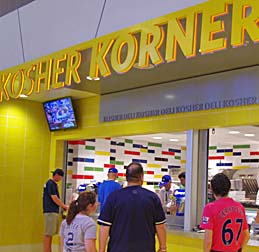 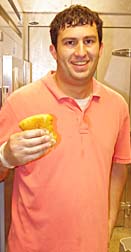  |
Not far away on the Promenade level is the Kids Shack stand (above right). Here you’ll find a kids’ hot-dog combo meal for $3.75, as well as candy and soft-serve ice cream.
And at every food stand, you’ll notice that the menu and prices are displayed on HD-TV screens. Not only does this allow Levy to change menu items on the fly (like, say, if they run out of an item), it also facilitates a bilingual approach with no wasted space, because every few seconds, each screen switches from a menu in English to one in Spanish (below left). I mean, you can’t go to the ballpark and not get a Perro Caliente, can you?
Truly Marlins Park is nothing if not bilingual, and it is obvious that a really high percentage of the fans in attendance don’t utilize English as their primary language, if at all.
As mentioned earlier, there is a run on Marlins merchandise and apparel, mostly because of the change from Florida to Miami. “All across the country, the city of Miami is considered to be a really cool place, and we are selling a lot of shirts and caps (outside of Florida) with the word ‘Miami’ and the new logo on them,” noted Kitch. Of course, in his on-site retail operation, he faces a challenge in having two smallish stores instead of one huge one. The store shown below, the one you enter from the West Plaza, is the slightly larger of the two.
The prices on the merchandise are in the middle of the pack at MLB stores these days. Adult T-shirts are $25 and $30, as are adult caps. Shirts for kids are typically $20, while caps are $22. My favorite souvenir items, lapel pins, are reasonably priced at $5, but I was disappointed that none showed the new ballpark.
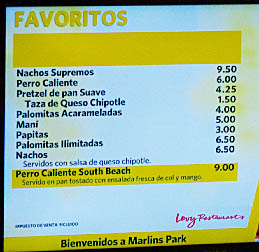 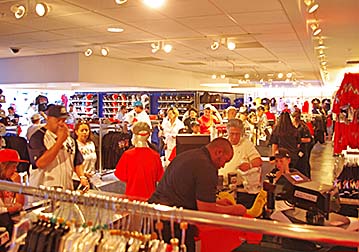 |
I’m very, very happy to report that Marlins Park is filled with a wonderful, traditional baseball sound: the organ. Dick Jans (below left) is the gifted organist who plays prior to games and between certain innings. “We’re fortunate to have a (game) producer here who still believes in traditions like a live organ,” Jans told me. I couldn’t agree more, because I get sick of hip-hop music blaring from the speakers of ballparks. I do wish, though, that Jans could do his playing from a more-visible location in the park, like at US Cellular Field, where there’s a designated booth for their organist on the main concourse. As it is, Jans plays from the area of the press level where the scoreboards and other operations are handled.
As mentioned earlier, Marlins Park possesses three huge, high-definition video screens. One is actually outside the stadium above the West Plaza, and there is also one beyond left field. The granddaddy of them all, though, is high above center field. It’s high-def and provides an enormous amount of info, perhaps bordering on being too busy. It’s also possibly the only video screen in pro baseball that isn’t rectangular. As you can see in the photo below, it is a trapezoid — more of that geometry that Populous was trying to scatter around the ballpark!
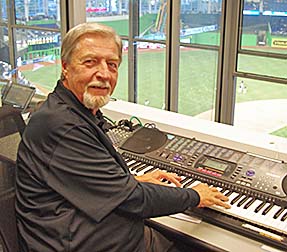 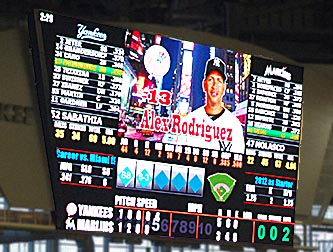 |
And as mentioned earlier, the fact that Marlins owner Jeff Loria is an art dealer is quite significant, because there is art everywhere you look in Marlins Park. In addition to the artful elements outside the park, you’ll find an enormous mixed-media piece entitled Play Ball (below center) by modern artist Kenny Scharf, Baseball Manager by Roy Lichtenstein, a hanging ceramic piece by Joan Miro and the most talked-about of them all, the Home Run Sculpture (below left). Sculptor Red Grooms created the 71-foot-tall structure specifically for Marlins Park, at a cost of $2 million. When a Marlin hits a home run, the sculpture comes to life, with chains moving marlins and seagulls in circles, while a water canon blasts water high into the air.
A columnist in Miami dubbed it the love-it-or-hate-it sculpture, with good reason. Many around the country have found it to be tacky or garish, but it wasn’t designed for people around the country. Its bright colors and in-your-face movements aren’t for me, but I would argue strenuously that it is absolutely perfect for South Florida.
And I don’t know if you’d call it art, but it sure is interesting. On the Promenade concourse behind home plate, you’ll find the Bobblehead Museum, an enormous display case that shows off almost 700 baseball-related bobbleheads. There’s even a computer that helps you locate your favorite player’s bobblehead within the display case.
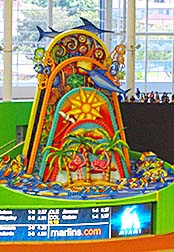  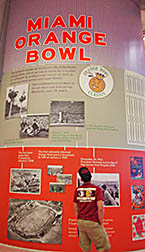 |
Finally, there is a wonderful touch within the ballpark that you might not notice if you’re not looking for it. On the Promenade concourse down the third-base line, you’ll find a support column adorned with tributes to the stadium that once stood where Marlins Park is now. Here you’ll find vintage photos of the Orange Bowl in its early days, along with timelines and descriptions of the biggest football contests played there.
Summary
“We are extremely pleased with Marlins Park,” Carolina Perrina de Diego, the team’s Director of Business Communications, told me. After the extended period where the team’s future in South Florida — and, well, their future at all — was in doubt, you certainly can’t fault the Marlins for being both happy and relieved to be in their new home.
“The ballpark plays a vital role in the franchise’s transition,” she added. “We could not be more proud and Marlins fans share that sense of pride with us.”
 |
There’s absolutely no debate whether the Marlins are better off in their new park than in Sun Life Stadium. One of my favorite comparisons between the old place and the new is this: Sun Life Stadium had 37,500 seats in the upper deck alone. Marlins Park has about 37,000 seats in the entire facility.
Smaller seating capacity, comfort, far more fan amenities, air conditioning and built only for baseball. Yes, the Marlins’ new ballpark is light years better than the football stadium they left behind.
And while there might be a little bit of art deco in the plush Clevelander lounge in left field, there is definitely no “retro” anywhere in Marlins Park.